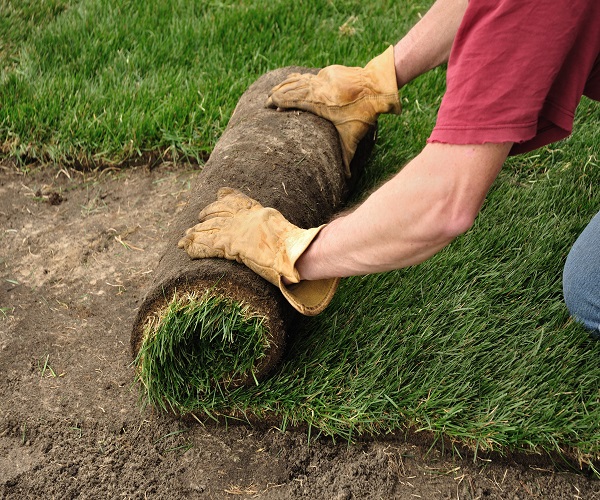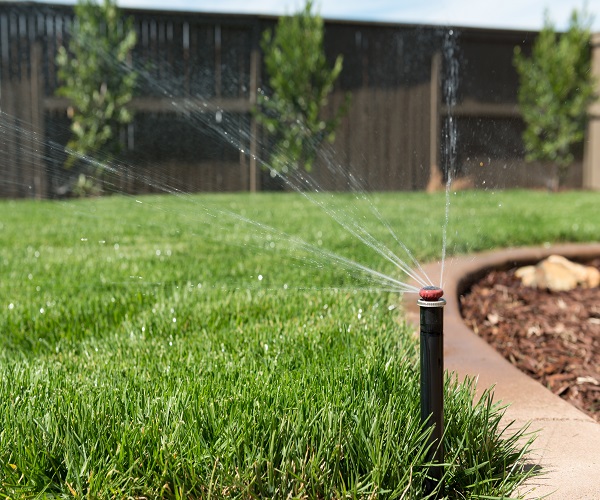Sod Watering Guide
Sod Care and Watering
Watering:
Water is essential to all life - too little water and we die, too much and we drown. The same is true
of the grass in our lawns. Water makes up 70% to 80% of the weight of our lawn grasses and the
clippings alone are nearly 90% water. While most people are concerned about not watering their
lawns enough, the fact is that more lawns are damaged or destroyed by over-watering.
Newly installed turf grass sod has very important watering needs. Proper watering immediately
after installation (first 2-3 weeks), will ensure the turf gets established, and it will also have an
impact on how well the lawn continues to flourish for years to come.
Weather conditions will dictate the amount and frequency of watering. Be certain that your new
lawn has enough moisture to survive hot, dry, or windy periods. As a rule of thumb you should
water your new lawn at least 2 to 3 cm. (1 inch) of water within 30 minutes of installation. Water
daily (at least once or twice a day), keeping the turf and its subsoil moist until it is firmly rooted
(about 2 weeks after installation). Following the first two weeks gradually decrease your watering
frequency depending on the current weather conditions.
Watering tips:
Watering Tip #1: Make absolutely certain that water is getting to all areas of your new lawn,
regardless of the type of sprinkling system you use. Corners and edges are easily missed by many
sprinklers and are particularly vulnerable to drying out faster than the center portion of your lawn.
Also, areas near buildings dry-out faster because of reflected heat and may require more water.
Watering Tip #2: Runoff may occur on some soils and sloped areas before the soil is adequately moist. To conserve water and ensure adequate soak-in, turn off the water when runoff begins, wait 30-minutes to an hour and restart the watering on the same area, repeating this start and stop process, until proper soil moisture is achieved.
**For the first 2 weeks keep the below-turf soil surface moist with daily (or more frequent) watering. Especially hot, dry, or windy periods will require increased watering amounts and frequency.
Watering Tip #2: Runoff may occur on some soils and sloped areas before the soil is adequately moist. To conserve water and ensure adequate soak-in, turn off the water when runoff begins, wait 30-minutes to an hour and restart the watering on the same area, repeating this start and stop process, until proper soil moisture is achieved.
**For the first 2 weeks keep the below-turf soil surface moist with daily (or more frequent) watering. Especially hot, dry, or windy periods will require increased watering amounts and frequency.


Watering Tip #3: Water as early in the morning as possible to take advantage of the daily start of
the grass's normal growing cycle, usually lower wind speeds and considerably less loss of water
because of high temperature evaporation.
Watering Tip #4: If the temperature approaches 100 degrees, or high winds are constant for more than half of the day, reduce the temperature of the turf surface by lightly sprinkling the area. Note: this sprinkling does not replace the need for longer, deeper watering, which will become even more critical to continue during adverse weather conditions.
Watering Tip #5: Infrequent and deep watering is preferred to frequent and shallow watering because the roots will only grow as deeply as its most frequently available water supply. Deeply rooted grass has a larger "soil-water bank" to draw moisture from and this will help the grass survive drought and hot weather that rapidly dries out the upper soil layer.
Watering Tip #4: If the temperature approaches 100 degrees, or high winds are constant for more than half of the day, reduce the temperature of the turf surface by lightly sprinkling the area. Note: this sprinkling does not replace the need for longer, deeper watering, which will become even more critical to continue during adverse weather conditions.
Watering Tip #5: Infrequent and deep watering is preferred to frequent and shallow watering because the roots will only grow as deeply as its most frequently available water supply. Deeply rooted grass has a larger "soil-water bank" to draw moisture from and this will help the grass survive drought and hot weather that rapidly dries out the upper soil layer.
Other Important Information on Watering:
If possible avoid hand sprinkling because it often cannot provide the necessary uniformity as most
people do not have the time to adequately measure what is being applied across large areas of
lawn.
Hose-End Sprinklers range in complexity, cost and durability, but are highly portable and can provide uniform and consistent coverage, when properly placed on the yard and adequately maintained.
Select sprinklers and systems for uniformity of coverage across whatever area they are designed to water. Inexpensive hose-end sprinklers and in-ground irrigation systems can provide uniform coverage, but must be regularly checked and maintained. Water timers can help provide consistency and even be programmed or set to turn-off when no one is awake or at home. Some timers measure just the amount of time water is flowing through the devise and you have to know or calculate how long to set the timer for. Other units measure the number of gallons of water flowing through it. **Knowing that 600 gallons per 1,000 square feet = 1 inch of water will help you calculate the timer settings your lawn will require.
Hose-End Sprinklers range in complexity, cost and durability, but are highly portable and can provide uniform and consistent coverage, when properly placed on the yard and adequately maintained.
Select sprinklers and systems for uniformity of coverage across whatever area they are designed to water. Inexpensive hose-end sprinklers and in-ground irrigation systems can provide uniform coverage, but must be regularly checked and maintained. Water timers can help provide consistency and even be programmed or set to turn-off when no one is awake or at home. Some timers measure just the amount of time water is flowing through the devise and you have to know or calculate how long to set the timer for. Other units measure the number of gallons of water flowing through it. **Knowing that 600 gallons per 1,000 square feet = 1 inch of water will help you calculate the timer settings your lawn will require.
Frequently Asked Questions about Sod:
Q: Is a sod lawn less work?
A: Yes, professionally sodded lawns require very little care because they are healthy and mature upon installation; whereas a sprigged or seeded lawn requires years of nurturing to reach maturity. Our sod is grown under expert supervision from top quality grass blends. After it has been installed, just water, mow, and fertilize as needed and enjoy a full, healthy turf cover for years to come.
Q: Where can I use sod?
A: Sod can be installed practically anywhere, even where seeding is impossible or too costly. Sod is often used to stop soil erosion and water pollution on slopes where rain would wash away both seed and soil. Sod is available in a variety of grass blends to suit various needs such as climate, amount of usage, sun and shade conditions.
Q: When can I use my sod?
A: It is best to give your sod at least 2 weeks to set before any heavy use. Light foot traffic to set sprinklers or cross sodded areas is okay immediately after installation however should be avoid as much as possible.
Q: Can sod withstand heavy usage?
A: Certainly! Sod establishes itself quickly. In only a couple of weeks, it's ready for full use. It creates the perfect surface for lawn games and family outdoor living. With our various blends of hardy grasses, sod is chosen for parks, golf courses, athletic fields, residential homes, and business parks.
We hope you find this information helpful. If you have any additional questions or concerns feel free to give us a call today at301-580-6023 or use the button below to fill out our online form!
A: Yes, professionally sodded lawns require very little care because they are healthy and mature upon installation; whereas a sprigged or seeded lawn requires years of nurturing to reach maturity. Our sod is grown under expert supervision from top quality grass blends. After it has been installed, just water, mow, and fertilize as needed and enjoy a full, healthy turf cover for years to come.
Q: Where can I use sod?
A: Sod can be installed practically anywhere, even where seeding is impossible or too costly. Sod is often used to stop soil erosion and water pollution on slopes where rain would wash away both seed and soil. Sod is available in a variety of grass blends to suit various needs such as climate, amount of usage, sun and shade conditions.
Q: When can I use my sod?
A: It is best to give your sod at least 2 weeks to set before any heavy use. Light foot traffic to set sprinklers or cross sodded areas is okay immediately after installation however should be avoid as much as possible.
Q: Can sod withstand heavy usage?
A: Certainly! Sod establishes itself quickly. In only a couple of weeks, it's ready for full use. It creates the perfect surface for lawn games and family outdoor living. With our various blends of hardy grasses, sod is chosen for parks, golf courses, athletic fields, residential homes, and business parks.
We hope you find this information helpful. If you have any additional questions or concerns feel free to give us a call today at301-580-6023 or use the button below to fill out our online form!
Contact us

